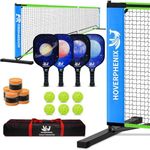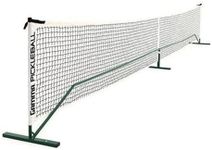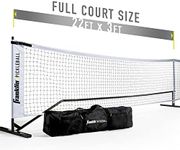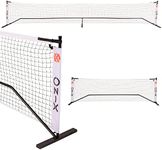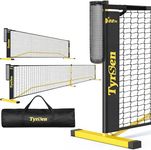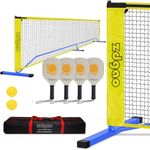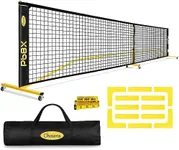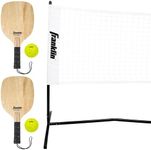Buying Guide for the Best Pickleball Net
Choosing the right pickleball net is important for both casual and competitive play. The net you select can affect your playing experience, setup time, and even the longevity of your equipment. When shopping for a pickleball net, it's helpful to understand the main features and specifications that set different nets apart. By focusing on your playing environment, how often you'll use the net, and how portable you need it to be, you can find a net that fits your needs perfectly.Net SizeNet size refers to the length and height of the net. Regulation pickleball nets are 22 feet wide and 36 inches high at the sidelines (34 inches at the center). This is important because using the correct size ensures fair play and helps you practice under standard conditions. Some nets are smaller for casual or practice use, which can be useful for limited spaces or younger players. If you want to play by official rules or plan to join tournaments, choose a regulation-size net. For backyard fun or limited space, a smaller net might be more convenient.
Frame MaterialThe frame material is what the net's structure is made from, usually steel or aluminum. This affects the net's durability, weight, and resistance to weather. Steel frames are sturdy and stable, making them good for frequent or outdoor use, but they can be heavier. Aluminum frames are lighter and easier to move, but may not be as robust. If you plan to set up and take down the net often or need to transport it, a lighter frame is helpful. For a more permanent setup or windy areas, a heavier, sturdier frame is better.
PortabilityPortability describes how easy it is to move and set up the net. Portable nets usually come with a carrying bag and can be assembled or disassembled quickly. This is important if you plan to use the net in different locations or need to store it away after use. Some nets are designed for quick setup and are lightweight, while others are more permanent and take longer to assemble. If you need flexibility and convenience, look for a net that emphasizes portability.
Net MaterialNet material refers to the fabric or mesh used for the netting itself. Most nets are made from nylon or polyester, which are both durable and weather-resistant. The quality of the net material affects how long it will last, especially if used outdoors. Thicker, tightly woven nets are more durable and less likely to sag or tear. If you play often or leave the net outside, choose a net with strong, weather-resistant material. For occasional indoor use, a lighter net may be sufficient.
Stability FeaturesStability features include things like wide bases, ground stakes, or weighted feet that help keep the net upright and steady during play. This is important because a stable net won't tip over or move during games, which can be frustrating. Some nets have extra support in the center to prevent sagging. If you play outdoors or in windy conditions, look for nets with enhanced stability features. For indoor or calm environments, basic stability may be enough.
Ease of AssemblyEase of assembly refers to how simple and quick it is to put the net together and take it apart. Some nets have snap-together frames or tool-free assembly, while others may require more effort. This matters if you want to spend less time setting up and more time playing. If you plan to move the net often or set it up by yourself, look for a design that is easy to assemble and disassemble.

